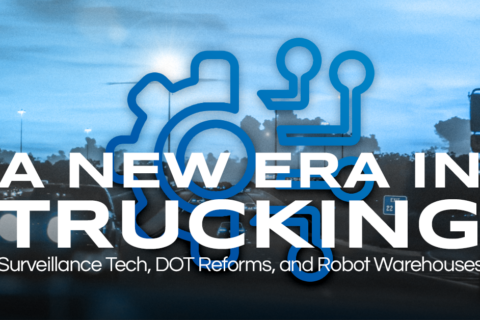A New Era in Trucking: Surveillance Tech, DOT Reforms, and Robot Warehouses
Welcome to another edition of our weekly digest that brings together some of the most pivotal happenings across the transportation and logistics industry. This week’s showcase touches on a variety of hot topics that are shaping the present and future of our industry. We delve into the controversial role of surveillance technology in trucking and the ensuing implications on privacy. Unpack the U.S. Department of Transportation’s push to crack down on predatory lease-purchase agreements and its commitment to making the trucking industry safer, more transparent, and driver-friendly. Lastly, we explore the future of warehousing and how multi-agent orchestration could revolutionize operations. Strap in and stay tuned as we navigate the highways and byways of the industry that keeps America moving. The Evolution of Surveillance in Trucking In the age of rapidly advancing technology, the trucking industry has experienced a considerable shift in its operational model. This article walks us through the story of owner-operator Danny Derrick, who started his professional trucking journey in 1968, relying on pay phones to communicate with his dispatch. Fast forward 55 years, the industry has undergone transformational changes driven by technological developments. The article posits that society, government, and industry leaders, driven by advancements in software technology, have increasingly sought to impose regulations and track activities of truckers through various technological tools, leading to a gradual erosion of driver autonomy. The Implications of Technology for the Trucking Industry Karen Levy, an associate professor at Cornell University, describes in her book “Data Driven: Truckers, technology and the new workplace surveillance,” the effects of using technology as a regulatory and surveillance tool on the trucking workforce. The introduction of the ELD (Electronic Logging Device) mandate in 2017, for instance, has resulted in a shift from flexible record-keeping to mandatory logbook data transmission for law enforcement purposes. This, along with the potential implementation of full electronic inspections, speed limiters, and other digital tracking tools, has raised concerns over an invasion of privacy in the trucking community. The article also discusses the role of smartphones as a double-edged sword, offering benefits like entertainment and business functionality while simultaneously pulling drivers into a tech ecosystem that can potentially lead to increased surveillance. Cracking Down on Predatory Trucking Practices The U.S. Department of Transportation (U.S. DOT) is setting its sights on eliminating predatory lease-purchase agreements that persistently put truck drivers in disadvantageous positions, according to Secretary Pete Buttigieg. Such arrangements often involve truck leasing to drivers by a carrier, with the carrier taking a portion of the load payment, leaving the driver with little or no profits. Instances have been reported where drivers end up owing money to the carrier, never truly owning the truck despite making numerous payments. In response to this, the 2021 infrastructure law enacted a provision to establish a Truck Leasing Task Force within the Federal Motor Carrier Safety Administration (FMCSA). New Task Force: A Beacon of Change Buttigieg joined Land Line Now to discuss the issue, stressing the importance of transparency in lease agreements. He argued for the implementation of rules and regulations around these contracts to prevent unexpected circumstances, such as higher mileage trucks, lack of test drive opportunities, or complex service contracts, which could create a discrepancy between expected and actual earnings. Buttigieg stressed that these are areas of concern for the U.S. DOT and indicated reliance on the task force’s expertise for policy decisions. The FMCSA’s Truck Leasing Task Force, with its nine diverse members, is expected to investigate commercial motor vehicle lease agreements’ effects and develop best practices for future agreements. Valuing Essential Workers Buttigieg’s remarks at the inaugural meeting reflected a keen focus on ensuring that truck leasing agreements do not trap drivers in predatory situations. He further noted the negative impact of lopsided leases that prevent drivers from making financial headway, often leaving them in a worse state than when they started. Buttigieg asserted that such conditions are unacceptable for any worker, especially essential ones like truck drivers. FMCSA Administrator Robin Hutcheson identified these predatory practices as a safety concern and emphasized the need for improving drivers’ overall quality of life for industry retention. Tying Driver Retention to Safety The U.S. DOT is keen on enhancing driver retention, a priority stemming from the connection between experienced drivers and safety. The FMCSA reports that turnover rates for large long-haul carriers are above 90%. Buttigieg insists that if drivers feel compensated well, have a good quality of life, and feel safe, retention numbers will improve. Buttigieg’s words suggest a barometer of progress towards eliminating predatory practices and establishing fairer trucking conditions. 🔗 Read the full article here The Future of Warehousing: Multi-agent Orchestration The logistics industry’s next big breakthrough could lie in a burgeoning technology known as multi-agent orchestration. According to Akash Gupta, co-founder and CEO of robotics fulfillment firm GreyOrange Inc., multi-agent orchestration provides the freedom for retailers to choose their own set of robotic technologies, aiming to create a seamless warehouse workflow. This includes integrating diverse fleets of mobile robots, even those from different manufacturers. Moreover, Gupta suggests the appeal of this technology comes from its ability to coordinate different types of robotic solutions suitable for varying types of fulfillment centers, such as dark stores and omnichannel fulfillment centers. Embracing Automation in the Logistics Sector A recent Gartner report predicts that by 2026, over 50% of companies deploying autonomous mobile robots (AMRs) in their warehouses will have a multi-agent orchestration platform. This finding is supported by a survey, in which 86% of respondents plan to expand their robot fleets, and 96% intend to use robotics for new tasks in the workplace. Dr. Larry D. Parker Jr., a logistics expert, believes that the shift towards automation in commercial transportation and logistics has been prompted by the pandemic, highlighting the need for supply chain optimization and automation. Notably, robotics and automation have been part of the warehouse industry since the early 1960s, and with approximately 2.7 million industrial robots currently in use worldwide, this figure is only set to grow. The…



Recent Comments